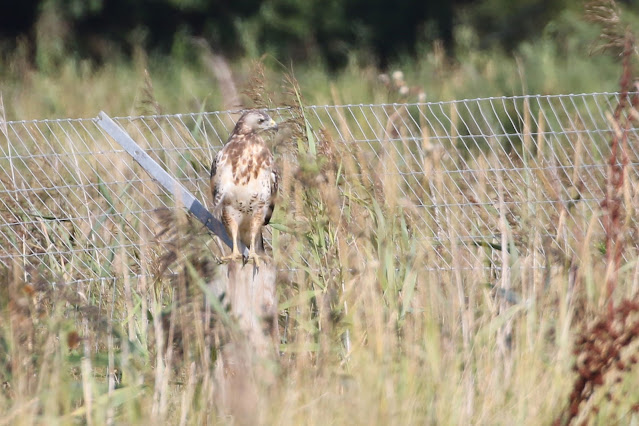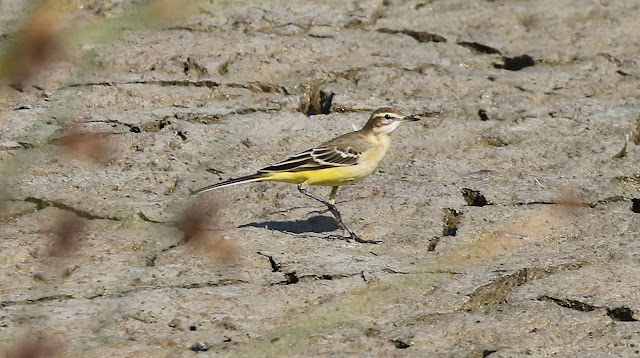As we approach the autumn equinox the sun rises much later and it is not such a challenge to get about of bed to ensure I arrive at any destination just before sun rise. In fact I really enjoy the drive and the darkness gives way to light as I head south. Today I was meeting Ian at the sea wall at Hill Head. As I arrived the reserve was captured in the pre-dawn light and covered with mists across the reed bed, while the low tide revealed the mud alongside the reeds
I walked around to the harbour where the sailing yachts lay amongst the mud in the harbour
All the duck, that congregate around the sluice during the day in hope of being fed, were further out at the harbour entrance.
Stepping back the sun as it started to rise through some orange light out across the sky and was reflected in the still waters of the harbour.
With the sun rising the mists across the reserve reed bed become more intense.
There were Gadwall and Teal dabbling in the shallow water of the lake, while Black-tailed Godwits and Redshank fed amongst the exposed mud.
Cloud and mist had obscured the sunrise, but eventually the cloud broke a little and sun came through.
This then changed the sky above the reserve looking south.
The rainbow bar was covered in what must have been well over 100 Mediterranean Gulls. They were joined by a few Ringed Plover, Turnstone and Black-headed Gulls. Off shore there was a huge feeding flock of gulls, but a combination of morning mist and distance made it very difficult to make any firm identification.
As the tide rose and started to cover the shingle bar, the gulls started to move away, all mostly heading out into the Solent.
The squeals and screams of Water Rails in the reed bed close to the road finally produced two individuals flying across the lake and feeding close the reeds and the shore of the mud. This is an adult while the other individual that appeared was a juvenile bird.
Early morning looking south on a sunny morning is always a beautiful sight, here a wide panorama of the reed bed and reserve.
This Little Egret came off the beach and flew over my head, flying in the direction of the reserve.
Everything about the weather forecast through the week was good news, overcast with a fresh south easterly wind. However the reality was a little mist first thing that cleared, a very light easterly breeze and clear skies. As a result there was nothing moving on the sea, so we decided to go for a walk up the canal path, as we crossed the road a Sparrowhawk appeared above the Meon Shore Hide and then with an incredible turn of speed dived and flew straight into the bushes where two Stonechat had just been. We don't think the Sparrowhawk was successful but we didn't see it again.
There were Whitethroat and calling Chiffchaff as we started along the Canal Path. I saw a Moorhen swim across the canal and then assumed that when Ian saw ripples it was the same bird. This wasn't the case as Ian pointed out a Water Vole, my first sighting for a few years. It was sitting on a branch just above the water and was aware we were there
It remained still watching and listening as the camera clicked, never moving from the position.
Then it turned and dropped into the water with the familiar "plop". It is always described as such and in this case it was. Then it was gone leaving just a few bubbles.
The Canal Path is still green, but is beginning to take on an autumnal look as the leaves turn pale and yellowish and there are the early falls along the path. Fortunately the path is still very dry and no sign of the mud that will cover it come the winter.
The first butterfly was a Red Admiral soaking up the sun on a patch of nettles, this was to be the first of many seen through out the day.
Another insect taking in the morning sunshine was this Migrant Hawker dragonfly.
Then a little further along a Comma in the sunshine with a lovely dark background and the dappled shadows on the bark of a Silver Birch.
We had been hearing Swallows above us as we walked the path, but on reaching the open fields about halfway along there were at least two hundred birds flying around the field and resting on the over head cable.
Another view of the canal on a beautiful autumn morning.
The only down side of the Canal Path in the early morning is the sun directly in your face as you look west across the water meadows. It is here you are more likely to find the migrant chats and this was the case today with several Stonechats and two Whinchats. It is always difficult to get the photograph though.
On reaching Posbrook Floods Ian picked up a small duck that was a good candidate for a Garganey, he photographed and could see the stripe on the head. The identification was clinched though as it flew off and you could clearly see the light grey to pale blue forewing. It headed north up the valley and out of sight.
At the bridge we walked up the path with Long-tailed Tits calling from the trees along the side of the path. We decided to walk through the fields parallel to the canal. We passed a field of French Beans, then this larger pumpkin patch with some big pumpkins.
Another Migrant Hawker was seen in the hedge dividing the fields.
Next a field of Sunflowers, a magnet to the bees.
Other than a continued passage of Swallows and several Meadow Pipits there was very little else to be seen. We dropped back on to the Canal Path at Hammond's Bridge and where the canal crosses the path and goes into the reserve there was a large shoal of fish, mostly Roach and Rudd, there were also several Bleak.
In the bushes at the bottom of the path opposite the toilet block another Whinchat was showing quite well alongside a Stonechat.
We went into the reserve and straight to the Meon Shore Hide. Looking out across the scrape it was dominated by a large gathering of Black-headed Gulls. The tide was now high, but I can't recall seeing so many Black-headed Gulls at this time of year.
Where a couple of weeks ago there were a lot of waders on the scrape, today it was pretty much devoid of them save for five Redshank to the right in front of the reeds, one or two Black-tailed Godwits and the usual Oystercatcher roost.
There was a few ducks and some of the Teal were already showing almost complete winter plumage. Gadwall were displaying and out in the middle were my first Pintail here for the autumn
Suddenly all the gulls went up and were joined by the Lapwing and Godwits, checking the skies there was no sign of a raptor, but then the culprit was pointed out on the left hand side, a Buzzard.
It somehow had flown across the scrape as it had been present on the east side of the scrape earlier. It then moved to another post where it appeared to be interested in upsetting everyone again, but eventually flew off to perch in the dead tree along side the West hide.
The one thing the Buzzard managed was to send a Ruff down to the mud in front of the hide, where it posed and wandered a round for a few minutes allowing us the chance to get some good shots of at least one wader.
There had been reports of Wood Sandpiper, but we couldn't find any at all, maybe this Ruff was a case of wrong identification.
Thin "seep" calls above heralded the arrival of one, then two Yellow Wagtails. They started off a little distance away to the left of the hide, but a little willing and they gradually made there way to the mud in front of the hide, skipping and jumping to catch insects as they went.
It was then back to the car for lunch, then off around the hides on the east side of the reserve. It was very quiet with a Kestrel and four Stonechat from the Knights Bank hide, being the bird highlight, while the Common Darters settling on the board walk banisters posed a challenge.
I decided to check all the hides on the west side once again, as I walked around to the entrance a couple of Common Gull were perched on the posts in Duck Lake, I think the Common Gull is my favourite of the commoner gulls, they have a very pleasing, less menacing, appearance.
A quick check of the Meon Shore Hide showed little difference, there were though three Ruff at the top end just below the Pumfrett hide. Walking around to them, the sun made it impossible to see them properly.
I was taken by this hover fly, Helophilus pendulus. The scientific name means "dangling marsh lover". It is apparently a very common species in Britain, but I was taken by the orange and black markings.
Moving to the Spurgin Hide the situation was very much like all the other hides, very quiet. Coming out I took on the Common Darter challenge once again.
I also noticed one high up




















































No comments:
Post a Comment